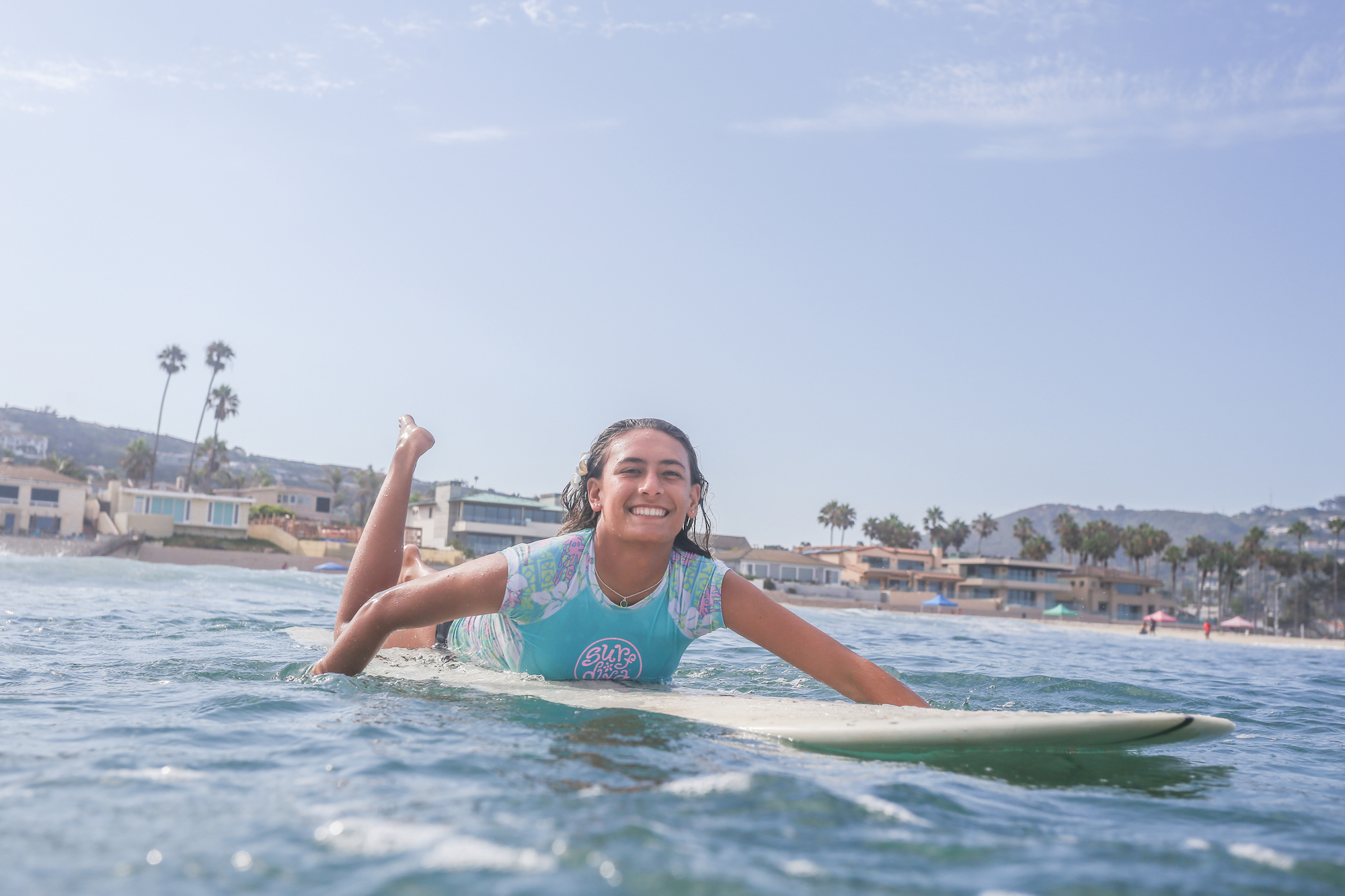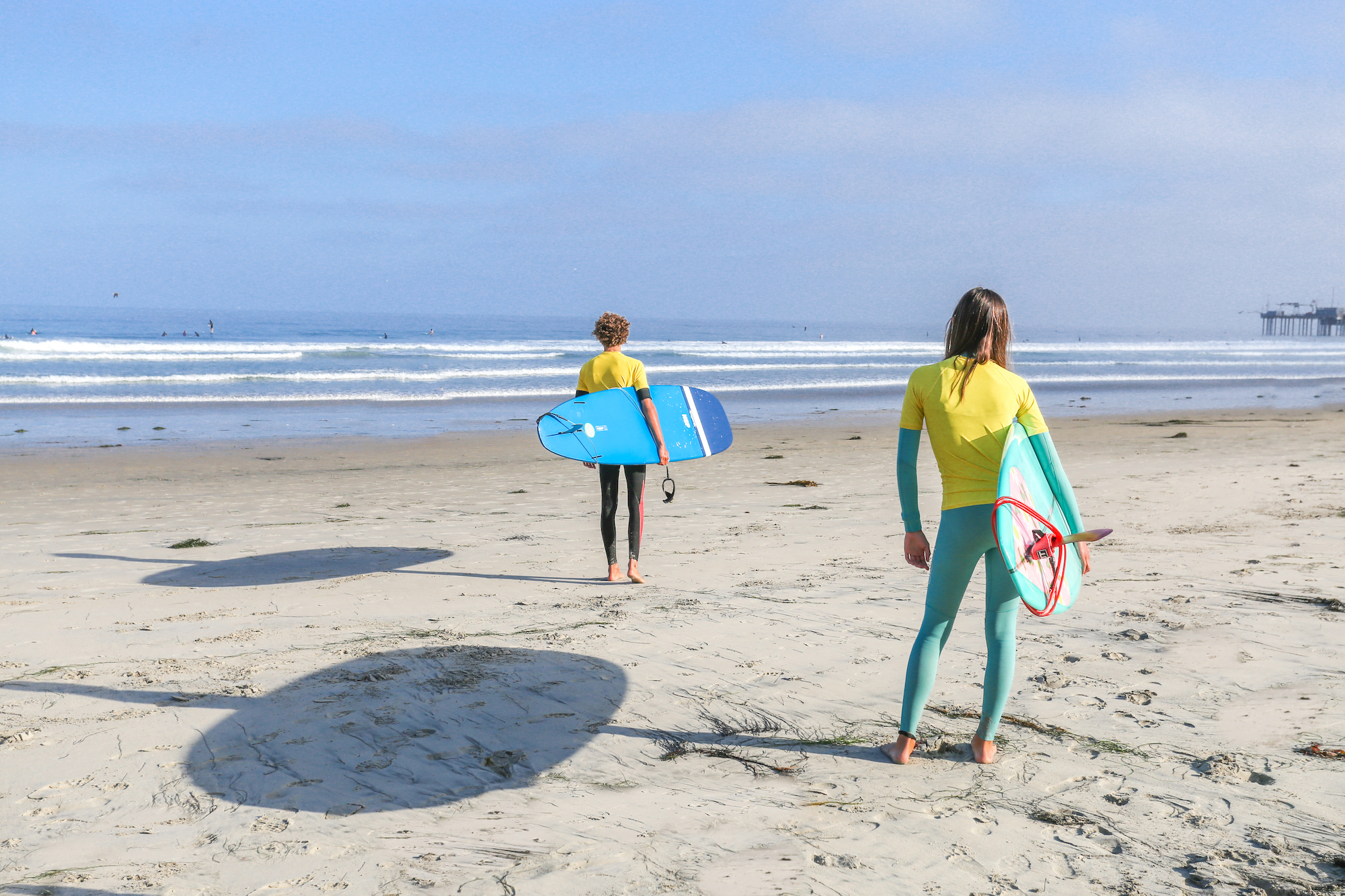
How to Learn to Surf: Beginner’s Guide + Tips
Hey, future Surf Divas and Divos, welcome to your surfing journey. You might be standing at the shore now, thinking, “Can I really do this?” The answer: absolutely yes. We’re going to walk you through how to learn to surf, from picking your first board to catching your first wave, with the friendly mentor energy and confidence boost that’s pure Surf Diva. We’ll also show you how our surf lessons can accelerate your progress and shave off months of struggle. By the time you finish reading, you’ll feel less like a total beginner and more like someone who deserves a shot at that set wave.
Understand surf mindset & safety
The ocean belongs to no one, but welcomes everyone. Surfing isn’t about conquering the sea, but about dancing with it. Respect currents, rips, tides, and always watch how the waves break. Being humble is your best friend.
The basics of surf etiquette
- Don’t drop in on someone: The surfer closest to the peak of the wave has the right of way. If someone is already riding a wave, do not take off on the same wave.
- When paddling out, avoid the path of surfers riding waves. Paddle towards the broken part of the wave (whitewater) rather than the unbroken part.
- Despite all efforts, if you find yourself in the way, move quickly and efficiently out of the surfer’s path.
- Hold onto your board at all times. Learn a proper technique to get through breaking waves. The turtle roll is a great way to get started.
- Spread the Aloha spirit in the water! Connect with your fellow surfers, and if you accidentally get in someone’s way, apologize and be friendly.
- Choose the right location and spot to practise. La Jolla Shores is the best beach in San Diego for beginner surfers.
- Most importantly, take a surf lesson from a professional licensed surf school. Your instructor will show exactly who has the right of way “priority” and why. Proper etiquette will make you more friends in the water and on land.
- Consider reading Surf Diva: A Girl’s Guide to Getting Good Waves for more details and basic illustrations of how to be in the right spot in the lineup.
These surfer rules of etiquette may sound minor, but they prevent injury and make for a great experience when you learn how to surf.
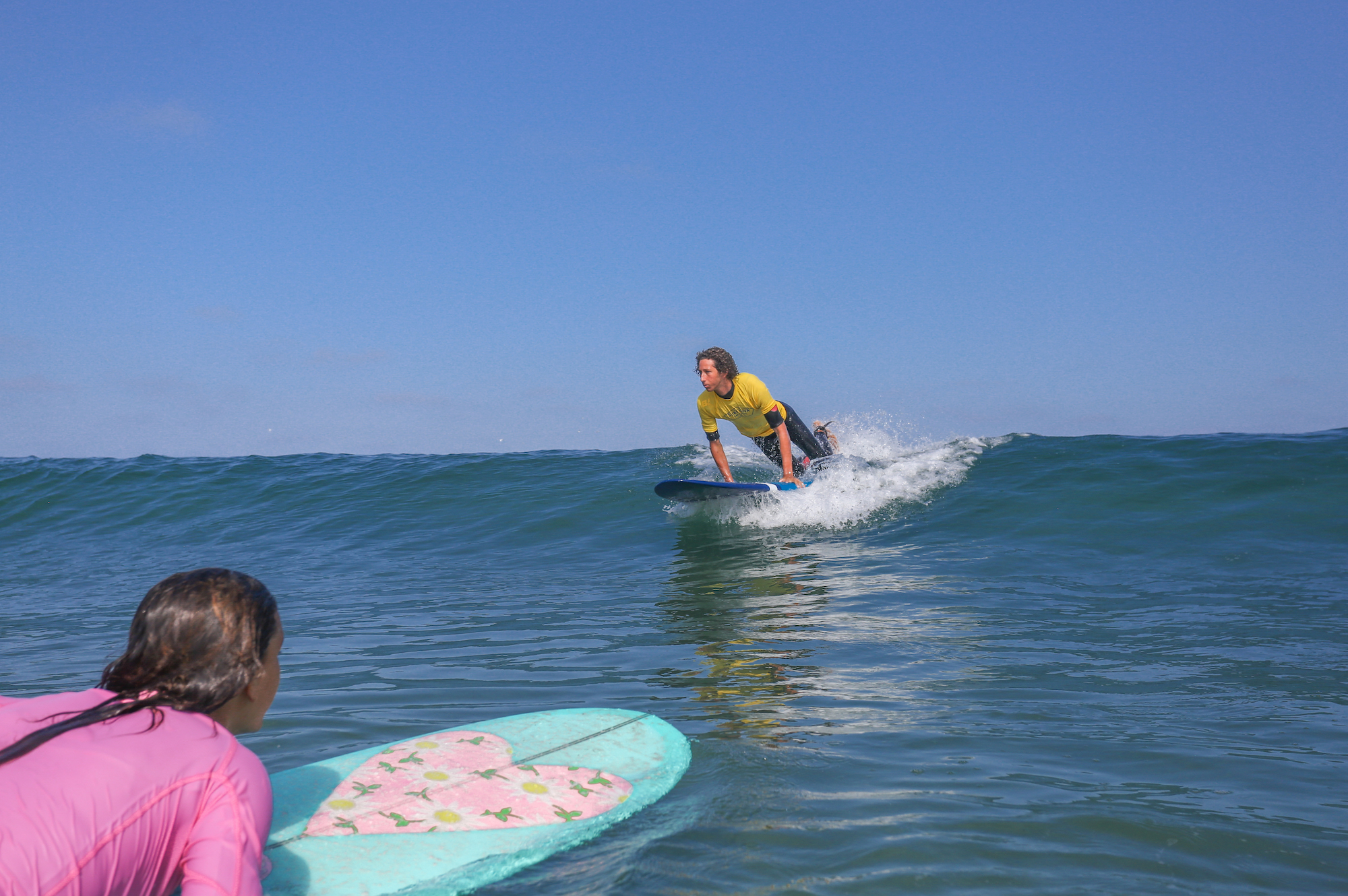
Safety gear & BASICS
- Use a soft-top beginner board (8-9ft) with a leash and plenty of foam. Foam is your friend!
- Always wear sunscreen and protect yourself from the sun and cold water with a wetsuit.
- Learn how to fall away from your board, protect your head, and surface calmly
- Check out our Ultimate Guide on how to choose the Best Beginner Surfboard
Pick the right spot & timing
Choose beginner-friendly breaks
When you’re learning how to surf, the type of waves you choose can make or break your first experiences. You want mellow, forgiving waves, not giant, intimidating barrels. Look for gentle whitewater or beach breaks with soft, rolling waves that let you practice your balance, paddling, and pop-up safely.
One of the best places to learn is La Jolla Shores, home of Surf Diva Surf School. This iconic San Diego beach has earned countless awards as one of the best beginner and intermediate surf spots in California, and for good reason. The sandy bottom, consistent swell, and friendly vibe make it the perfect classroom for new surfers. Whether it’s your first lesson or your fifth, you’ll find waves that help you progress without pressure.
Know the surf conditions
Before you paddle out, take a moment to understand what’s happening in the ocean that day. Checking local surf forecasts helps you read the conditions like a pro. Pay attention to swell size, wind direction, and tide changes, as these factors determine how clean, powerful, or messy the waves will be.
For beginners, smaller swells, little wind, and mid-to-higher tides usually create the smoothest, most manageable surf. You can easily check conditions using Surfline.com or tune in to Bird’s Surf Report on 91X radio (daily at 7 am, 12 pm, and 7 pm). Understanding surf reports not only boosts your confidence but also keeps you safer and maximizes your wave count.
If all that still sounds like surfer code, don’t worry, during your Surf Diva surf lessons, our instructors teach you exactly how to read the ocean so you know when (and where) to paddle out with confidence.
Best times to surf
Timing can make all the difference. The best times to surf, especially in Southern California, but really in most places with good surf, are typically early mornings or late afternoons. These “golden hours” offer lighter winds, fewer crowds, and that magical California golden light that makes every wave feel cinematic.
Mornings tend to bring the cleanest waves thanks to calm offshore breezes, while evenings let you unwind in the soft sunset glow after a day on the sand. At La Jolla Shores, these times of day are particularly special and you’ll often share the lineup with dolphins and experience the kind of serenity that reminds you why you started surfing in the first place. When you join a Surf Diva lesson, we’ll schedule your session at the ideal time of day for your skill level and local conditions — so you can make the most of every paddle, every pop-up, and every ride.
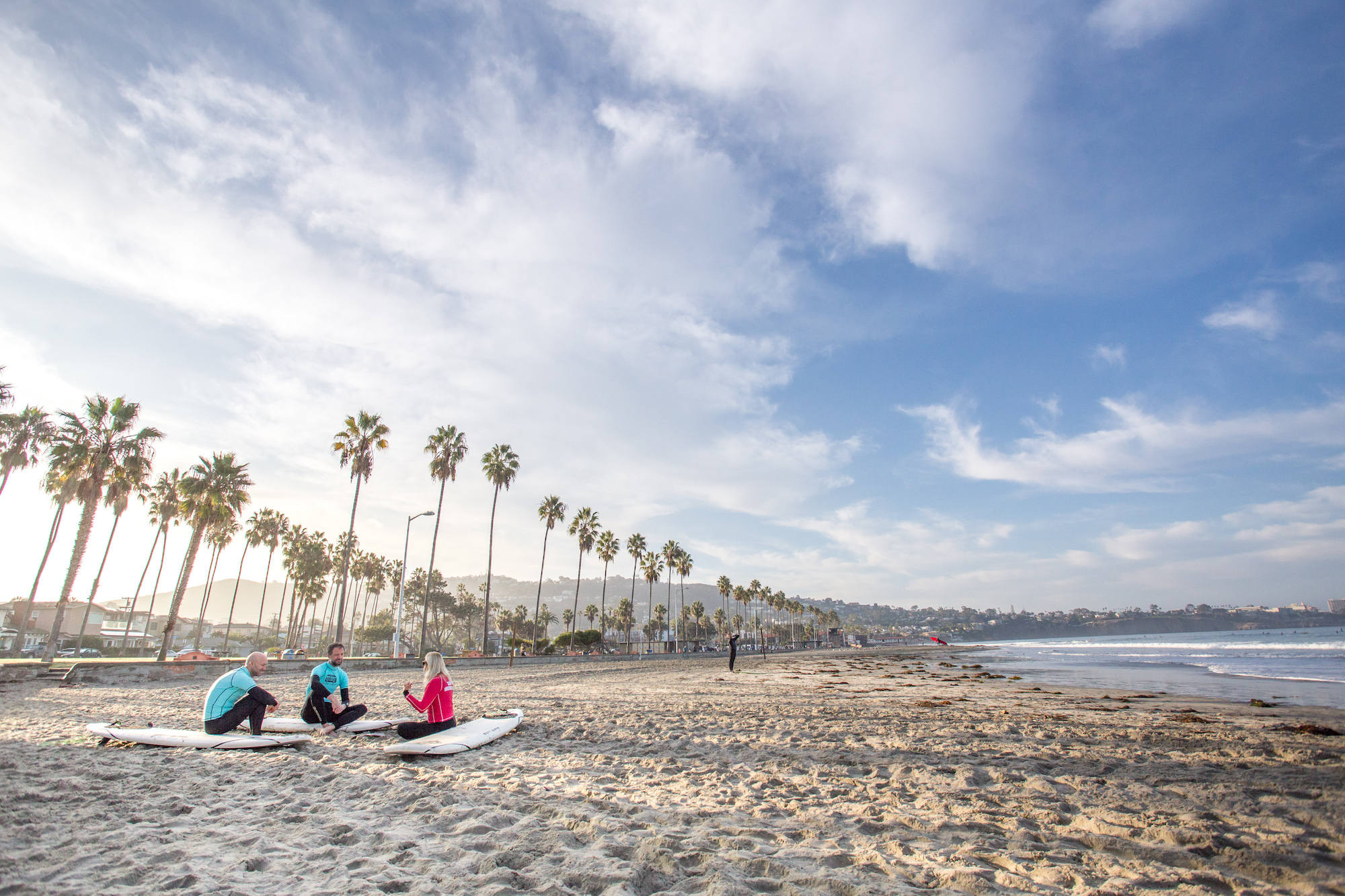
Gear up, but don’t overcomplicate it
- Beginner board: 8ft or more, soft top, volume, stable
- Leash: long enough so the board stays near, but not dangerous
- Rash guard or wetsuit, depending on water temp
- Wax to grip your feet
- Fin set up: usually 3-fin for stability, soft fins make for a safer experience as a beginner
Remember: having some gear is better than waiting for perfect gear. You’ll upgrade later. You can always rent gear at your local surf shop, even once you progress and learn how to surf, you can try out new board types by renting them before you purchase.
Practice on land first: pop-up & body positions
Step 1: Lie prone on the board, chest up, eyes forward
Step 2: Push up with your hands like a push-up, position your hand on the board, not the rails of the board.
Step 3: Slide front foot forward, back foot near the tail in one smooth motion.
Step 4: Bend knees, low center of gravity, eyes looking down the wave.
Do this on grass or sand 10-20 times, yes, sorry, we really mean it. Master it before your first ocean trial, because muscle memory is powerful. Also practice balance, stance, and trimming weight (lean forward/back) so your body already “feels” the balance.
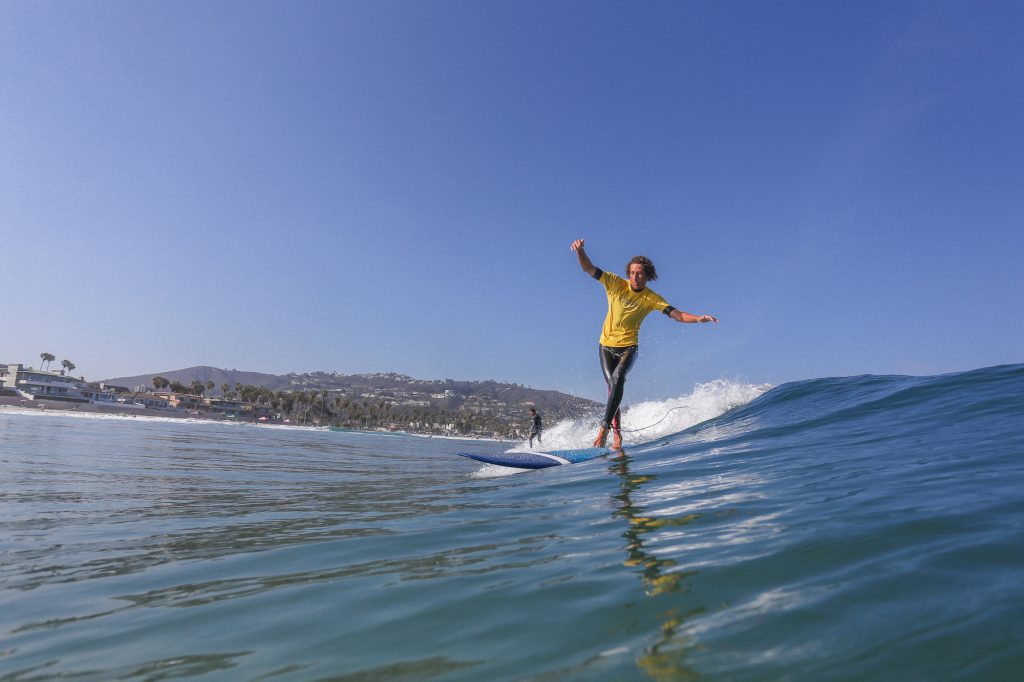
Getting into the water: Small waves only
When you’re ready to take your first waves, start in the whitewash and take the gentle, broken waves close to shore. They’re perfect for beginners because they give you the push you need without the power or wipeouts of bigger surf. Don’t worry about paddling all the way out just yet. Build your confidence and get a feel for your board in the whitewash. As you paddle, keep your body low and centered on the board. Reach forward with each arm, paddling deep and smooth, and avoid splashing. Look ahead toward the horizon, not down at your board, and use both arms evenly, one strong stroke per side. This rhythm will help you move faster and stay balanced.
When you feel a wave starting to lift your board, count three strong paddles and then pop up. Timing is everything: launch too soon and you’ll outrun the wave, too late and it’ll roll past you. Let the wave catch you.
As it starts to carry you, do your practiced pop-up just like you rehearsed on land, smooth, steady, and confident. Once you’re standing, keep your knees bent and your eyes forward. Shift your weight gently to steer, using your arms for balance rather than control.
And just like that, you’re riding your first wave. Enjoy it, with no pressure, no perfection, just pure joy and the start of your surf story.
Troubleshooting & common beginner issues
| Problem | Likely Cause | Fix / Drill |
|---|---|---|
| Board nose diving | Too much forward weight | Move weight back, pop up quicker |
| Late pop-up | Slow reaction/hesitation | Practice land pop-ups faster; gain flexibility |
| Losing balance mid-ride | Upper body too stiff / knees locked | Relax, bend knees, ride with slight bounce |
| Not catching waves | Poor paddle timing or underpowered paddle | Paddle earlier, deeper, stronger |
| Fear or hesitation | Nervousness, overthinking | Start small, trust the coach, breath control |
Progress step by step
Don’t rush ahead to advanced moves just yet. Surfing is all about steady progression and celebrating every small win along the way. Start by catching foam or whitewash waves to build your balance and timing. Once you feel comfortable there, move into slightly deeper water, about shoulder-depth, where you can start to feel the ocean’s real rhythm. From there, practice paddling outside the break on smaller days, that’s where the unbroken waves form.
When you’re ready, start catching those clean, unbroken waves. Focus on reading the swell, positioning yourself, and timing your takeoff. As your confidence grows, you can begin experimenting with gentle turns and trimming along the face of the wave, and that’s where surfing starts to feel like flying. Eventually, you’ll be ready to try more stylish maneuvers like nose rides or graceful cutbacks.
Every single ride, no matter how short, is a step forward. Celebrate them all! Each wave teaches you something new and brings you closer to the surfer you’re becoming.
How Surf Diva’s surf lessons make you better faster and safer
We built Surf Diva around surfer empowerment, safety, community, and joy. In our surf lessons:
- You get personalized coaching where instructors adapt to your pace.
- We handle wave selection, paddle timing, lineup positioning, so you don’t waste time making beginner mistakes.
- You surf in a 1:1 or with your friends or family.
- You get direct feedback, targeted drills, and encouragement from seasoned pros.
Many students who try on their own plateau for months. With our lesson, you’ll skip those plateaus, ride more consistently, and gain confidence faster.
We always suggest: practice on your own, but invest in surf lessons. It often pays back in wave count, confidence, and fewer wipeouts. Plus you will learn ten times faster than trying to learn “the hard way” without a qualified surf instructor.
Consistency, tracking, and mindset tips
- Try to surf 2–3 times per week if possible, because consistency is key.
- Keep a surf log: date, spot, wave count, notes. Over time you’ll see patterns. There are free apps, like Buio app who help you log your sessions.
- Watch and learn: inspect better surfers or study videos.
- Mind over matter: tell yourself, “I’m a surfer in training”, not “I’m a beginner”.
- Celebrate small wins: each ride, even a few feet, is progress.
When you’re ready, go ahead and book a Surf Diva surf lesson. We are happy to walk beside you when you’re ready to level up. Combine this guide, consistent practice, and coached sessions!
We want you to take a moment: visualize yourself paddling out, catching your first unbroken wave, smiling through salt spray and stoke. That version of you is real, we just need the right steps to get there.
